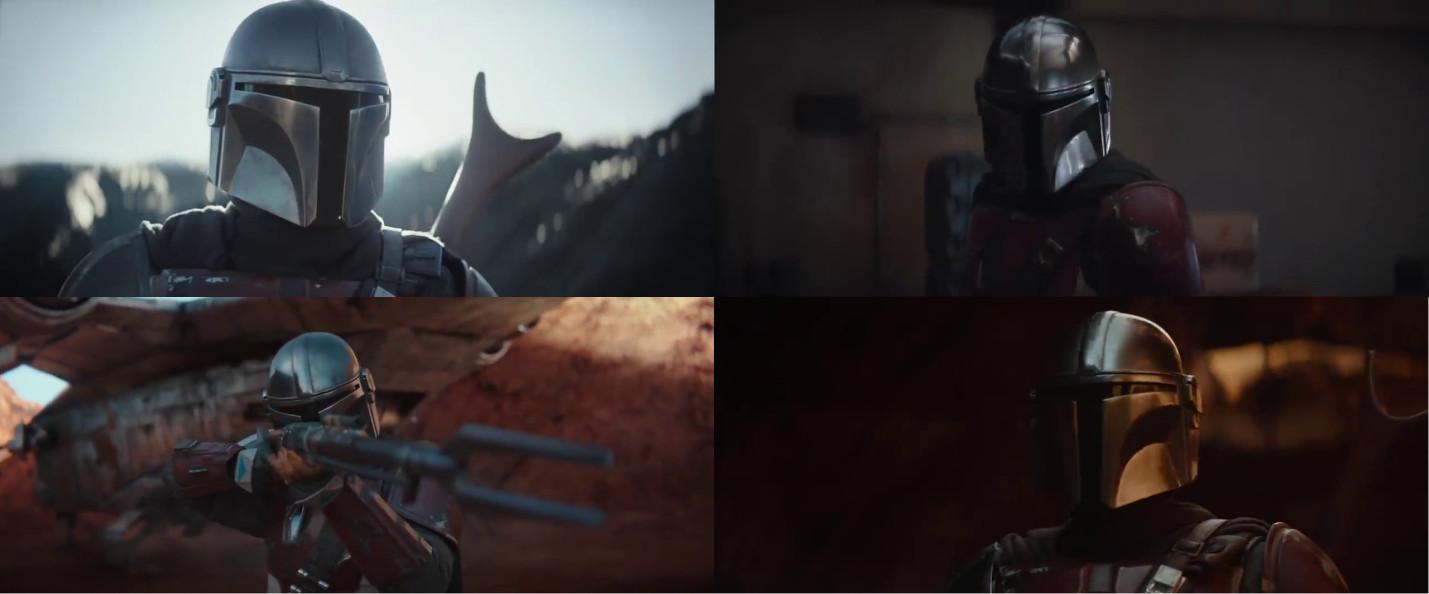At Star Wars Celebration in April, a theaterful of thirsty fans saw seven minutes of footage from The Mandalorian, the live-action series that will premiere on Disney+ on Tuesday. In those seven minutes, the titular bounty hunter, played by Pedro Pascal, delivered 13 lines.
That’s the same number of lines spoken by Jango Fett, Boba Fett’s father, in all of Attack of the Clones. By coincidence, it’s also the same number of lines uttered by bounty hunters other than Jango in every Star Wars movie put together (counting Bossk’s growl of untranslated Trandoshan in The Empire Strikes Back and Boba Fett’s dismayingly unmenacing scream in Return of the Jedi, but not counting kid Boba in Clones). Which means that by the end of the first episode of The Mandalorian, Pascal’s character will likely have eclipsed the combined dialogue and screen time of every other bounty hunter in the history of live-action Star Wars.
That might seem surprising, considering the prominent place the bounty hunting profession occupies in the Star Wars mythos. But before the still-unnamed Mandalorian raised them to the status of series lead, bounty hunters in live-action Star Wars were mostly seen and not heard—and they were seen only sparingly. They’ve always made the most of their minutes, but they haven’t earned many minutes until now, which is part of what makes The Mandalorian so distinct from previous on-screen Star Wars stories. After more than four decades, the most famous subset of Star Wars scum is migrating from the periphery of the frame to the center.
In the Star Wars Celebration sizzle reel, The Mandalorian creator Jon Favreau said, “This is a character you’ve never met before.” One could say the same about any character with a new name and face, but Favreau meant that the Mandalorian doesn’t fit familiar Star Wars archetypes. Although George Lucas gave us some of Boba’s backstory in Clones, bounty hunters in Star Wars have hardly been asked to emote. We’ve become acquainted with several bounty hunters in Star Wars films, from Greedo to the Fetts to Boba’s rivals in Empire (Bossk, IG-88, Dengar, Zuckuss, and 4-LOM) to the prequels’ Zam Wesell and Aurra Sing to the latest trilogy’s Bazine Netal, but we haven’t spent enough time with them to learn why they became bounty hunters, how the job works, and what they do during downtime. As creatures of the Outer Rim, they operate at the edges of the galaxy, the fringes of society, and the borders of the screen.
The first time we see Boba Fett in the Star Wars Special Edition, he’s standing off to the side, a voiceless supporting player.
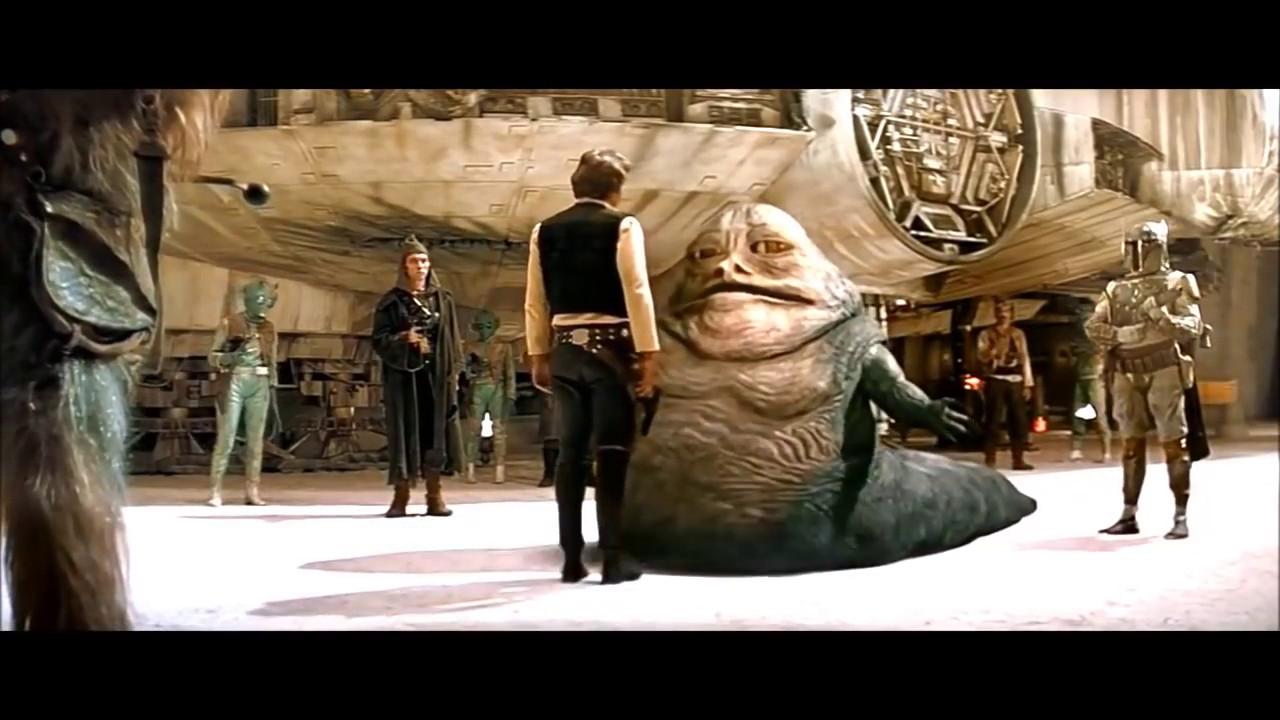
In Fett’s pre–Special Edition debut, he and IG-88 are dwarfed by Darth Vader and again sequestered on the side of the screen.
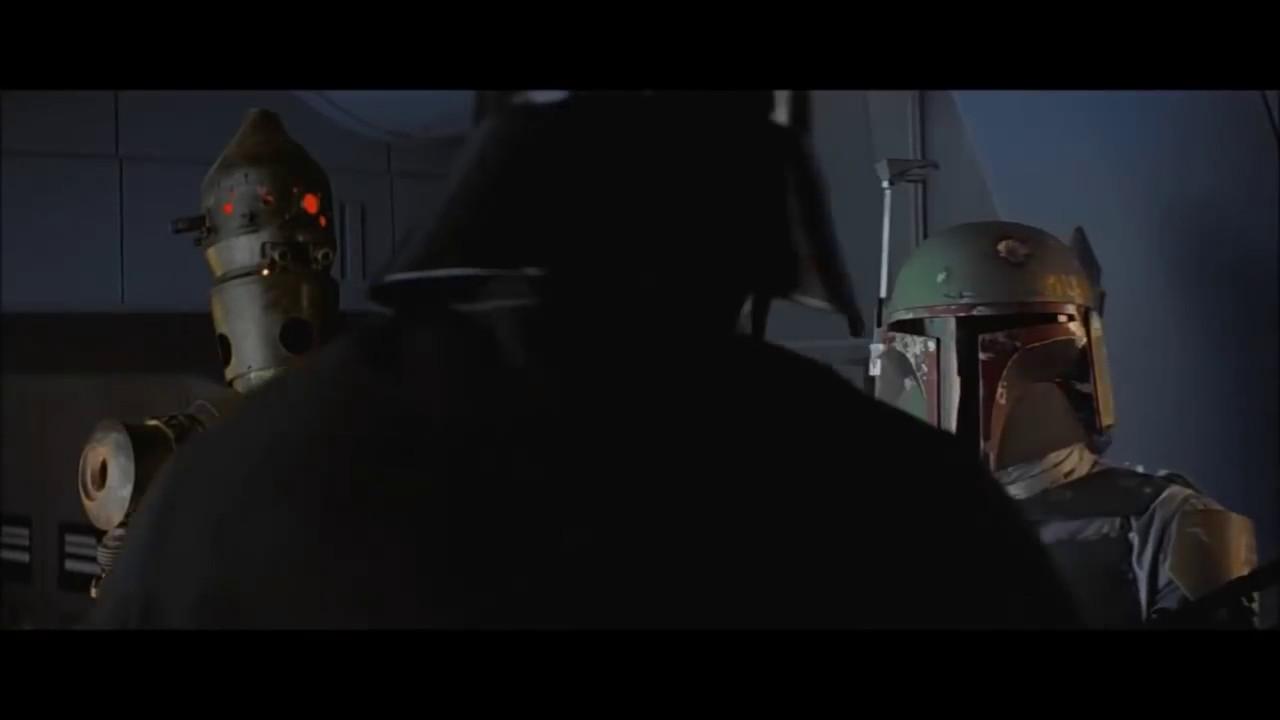
That’s something of a theme. Throughout the original trilogy, Fett is crammed into corners, hidden in darkness, blended into the background, or glimpsed from afar.
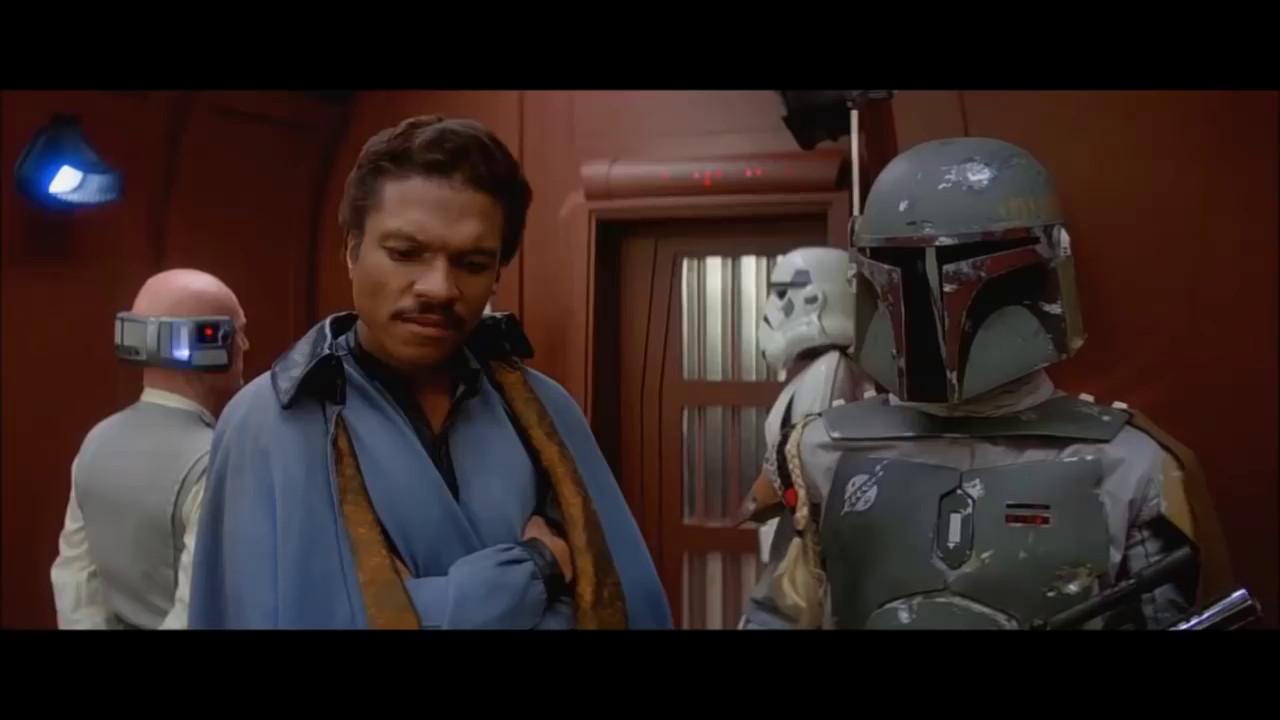
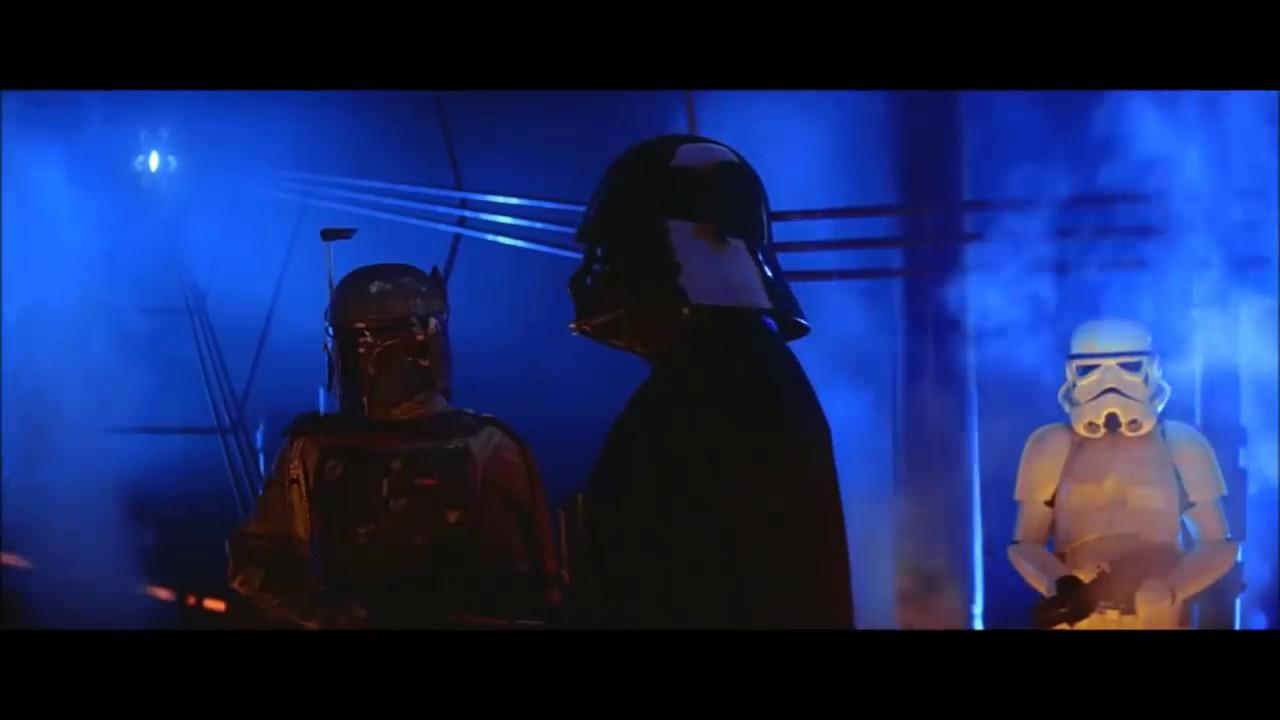
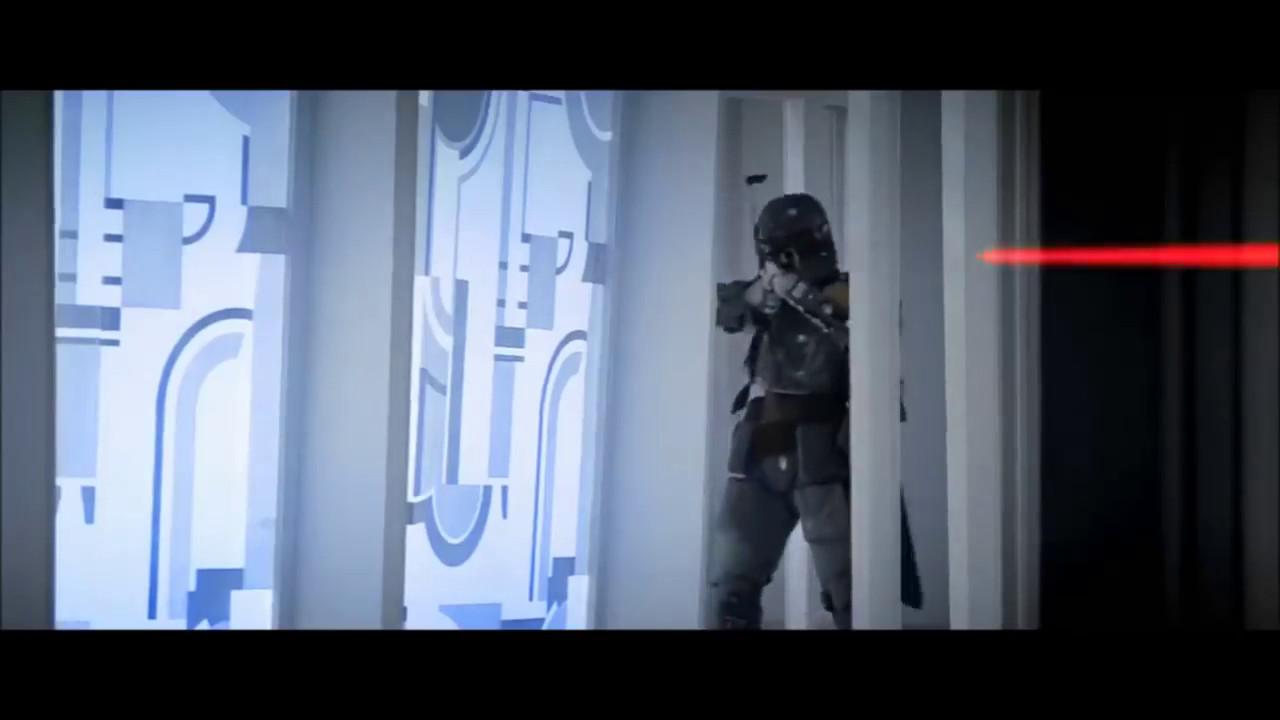
We view him from the side and from behind; we see him step sideways out of nothingness; we watch him walk into and out of the picture, a long way away. It makes sense for him to seem so remote, mysterious, and slippery: His performance hinges on his staying out of sight.
We can’t see what the adult Fett looks like under his helmet, although thanks to Jango, we’ve got a good idea. Bounty hunters’ armor provides protection in a dangerous job, but it also prevents us from accessing their interior lives. Most bounty hunters in Star Wars are cosmetic characters; in their own world, they may have many tasks to accomplish, but in ours, their sole assignment is to look cool. The best example of a bounty hunter who’s simply supposed to be part of the scenery is Sing, a character conceived not for any narrative purpose, but because Lucas needed people to populate The Phantom Menace’s podracing scene.
Constrained screen time and limited or nonexistent dialogue hasn’t stopped bounty hunters from becoming breakout characters. The brevity of their on-screen appearances actually enables their breakouts: By withholding information about these lethal-looking ciphers and their extralegal lifestyles, Lucas made them objects of fan fascination. Fett is one of the franchise’s most iconic figures. Even the visually striking but insubstantial Sing, who began fictional life as a sketch labeled “Babe Fett” and made only a two-second cameo in Episode I, went on to make many appearances in Star Wars books, comic books, and cartoons. Her Wookieepedia pages (canonical and noncanonical) run thousands of words. Because bounty hunters are catnip for serious Star Wars fans, both Sing and Bossk are briefly mentioned in Solo: A Star Wars Story, and Bossk almost made the movie.
Every second of the Star Wars films has been picked apart and fleshed out by generations of writers and fans, and the briefly glimpsed backdrops to the saga’s central struggle offer some of the most fertile storytelling territory. Just as Mos Eisley’s hive of scum and villainy provided fodder for dozens of franchise-sustaining tales during the lean years between trilogies, the understated presence of bounty hunters—also scum, at least from Admiral Piett’s perspective—was a world-building master stroke. The Empire scene that introduces six bounty hunters lasts about 40 seconds, but it’s a feast for the imagination. How did Dengar get those bandages? Couldn’t someone slap a restraining bolt on those two deadly droids? What kind of planets might birth exotic-looking life forms like Bossk and Zuckuss? And what did Fett do to invite that strict reminder about avoiding disintegrations?
The incongruous sight of six bounty hunters arrayed on the Executor’s gleaming deck was a statement in itself. The fact that Vader hired help implied that there were places where even the Empire’s power didn’t extend. By hinting at the existence of those unseen spaces, Empire’s bounty hunters made the setting of Star Wars seem like a living, limitless universe. Even a throwaway line like, “The bounty hunter we ran into on Ord Mantell changed my mind” offered infinite possibilities. Which bounty hunter? Where is Ord Mantell? What happened there? The Star Wars Expanded Universe has tackled those questions several times, although the stories inspired by that single sentence are now noncanonical (which means their events are ripe for revisiting).
Even though we’ve generally learned little about them, bounty hunters have helped us learn about other characters we care about. Greedo reveals that Han Solo is a smuggler, which Han had danced around during his conversation with Obi-Wan and Luke. In its original, “Han shot first” form, the encounter with Greedo demonstrates that Han can kill when his safety is at stake. And the threat posed by bounty hunters who might follow in Greedo’s footsteps helps sell Han’s subsequent decision to abandon the Rebel base before the Battle of Yavin, which makes it all the more cathartic when he rides to Luke’s rescue.
But bounty hunters aren’t just foils for other characters. They also advance the plot. In fact, from a certain point of view, Star Wars is secretly the story of galaxy-altering events set in motion by bounty hunters.
In Attack of the Clones, Zam Wesell’s failed attempt to kill Padmé points Obi-Wan to Kamino, where he discovers the clone army. It also separates Obi-Wan from his Padawan, which gives Anakin an opening to tell Padmé he loves her (and hates sand) and leads to their liaison, Padmé’s death, and Anakin’s downfall. Jango’s genes enable the Kaminoans to construct the army that cements the Emperor’s power and almost eradicates the Jedi. By tracking and trapping Han in Empire, Boba helps lure Luke to Bespin, which sets up Vader’s revelation that he’s Luke father. Boba transporting the frozen Han to Tatooine seals the emotionally draining ending of Empire and sets the stage for the opening act of Jedi, in which Leia—posing as another bounty hunter, Boushh—infiltrates Jabba’s palace. In The Force Awakens, Kylo Ren captures Rey—and jump-starts her discovery of her latent Force sensitivity—because Netal tips off the First Order to her presence on Takodana.
In other words, while one could cut every bounty hunter from the Star Wars movies and hardly reduce their running time, the saga wouldn’t work without them. Star Wars is the story of the Skywalker clan, but shadowy mercenaries motivated mostly by money make much of its plot possible. Like the Force, bounty hunters are an almost unseen influence that binds the galaxy together.
Over the years, bounty hunters have formed the basis of books (Tales of the Bounty Hunters), comics (The Bounty Hunters), and video games (Bounty Hunter). The Clone Wars was a hotbed of bounty hunting, featuring crossover characters from the films as well as original creations (including Cad Bane, who may be the best bounty hunter of all). But bounty hunters haven’t played a starring live-action role. The 2018 mothballing of a Boba Fett spinoff film barred the door to the big screen, but The Mandalorian may fulfill fans’ long-held desire to explore the seamy side of Star Wars—and in greater depth than a two-hour movie could.
True to tradition, we know next to nothing about the show’s protagonist, but we’re hours away from finding out more about both him and his trade, which Werner Herzog’s ex-Imperial administrator describes as a “complicated profession.” Bounty hunters have long been elusive—even literal shape-shifters, in the cases of Clawdites like Wesell and Remex Io. Now we’re really going to get to know one.
If there’s a potential downside to The Mandalorian focusing on characters who’ve thus far stayed out of the spotlight, it’s that making bounty hunting less hazy might sap some of its mystique. Overexplaining hasn’t served Star Wars well. Meeting Boba and Anakin as kids didn’t make the grown-up, armor-clad versions more compelling. Midi-chlorian counts damn near ruined the Force. We didn’t need to see the Kessel Run to know it was an impressive feat of flying, and learning how Leia stole Boushh’s armor didn’t really enrich her rescue attempt. Maybe chasing and wondering about bounty hunters is more satisfying than actually catching one. The most memorable disintegrations might be the ones we don’t see.
All indications are, though, that The Mandalorian will approach bounty hunting with far more finesse and badassery than The Phantom Menace brought to the Force. We never needed an explanation of the mechanics of a mystical energy field, but the nuts and bolts of bounty hunting should support a longer look. If the history of bounty hunters in Star Wars teaches us anything, it’s that we do need their scum. Starting Tuesday, we’ll see that scum in unprecedented detail.
As Nick Nolte’s Ugnaught (yep) says in a teaser for the series, “I’ve never met a Mandalorian. I’ve only read the stories.” The same could be said about Star Wars fans and bounty hunters, those enigmatic transients who’ve flitted through the frames of all but a few of the films. The Mandalorian is trying to do justice to the stories about bounty hunters that Star Wars fans have had in their heads. And for once, a bounty hunter won’t have to skulk on the outskirts of someone else’s scene. This time, he’ll have the screen to himself.
